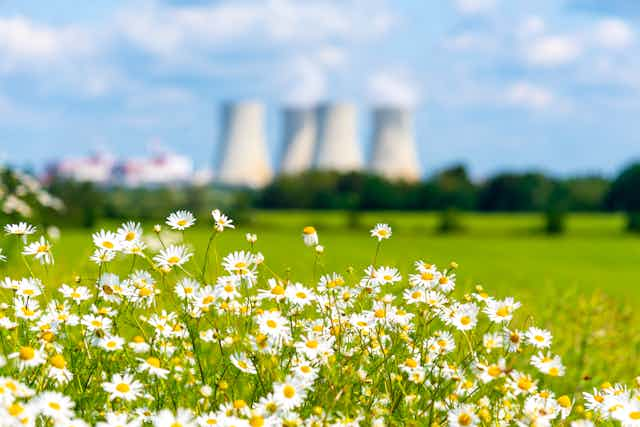Boris Johnson is set to announce at the Conservative Party conference in Manchester that all of Britain’s electricity will come from renewable sources by 2035, according to a recent report in the Times.
The government suspects that the British public – tired of petrol station queues and dreading winter gas bills – will like the idea of moving away from fossil fuels. But the nature of this energy crisis, stoked by a late summer lull in wind power generation, high wholesale gas prices and Britain’s meagre prospects for storing energy, demands a careful response.
And what energy technology offers low-carbon credentials and a reliable base supply? The UK government’s emphatic answer appears to be nuclear power.
Only three years ago, UK ambitions for new nuclear power plants were in trouble. Major Japanese conglomerates Toshiba and Hitachi had pulled the plug on their separate nuclear projects in the country. But with renewed support from Boris Johnson’s government, one of these now appears to be back on the table.
It was recently revealed that there are ongoing discussions between the government and American partners about US nuclear engineering firm Westinghouse building a new nuclear power plant on the island of Anglesea in north Wales. There is even talk of government support for Derby-based industrial giant Rolls-Royce to develop a series of smaller modular nuclear reactors. These are, in essence, scaled-down versions of traditional power plants that will generate 470 megawatts of electricity compared with the 1,000 megawatts from their larger equivalents. Importantly, with these new designs, true factory-based manufacture becomes possible. The factories produce modules for rapid assembly on-site.
Read more: Everything you need to know about mini nuclear reactors
There are likely to be benefits for British businesses in the government’s approach. But how would a new generation of nuclear plants help keep the lights on while cutting emissions from the energy sector?
The nuclear option
The reactors in nuclear power stations convert the heat generated by splitting atoms (a process known as nuclear fission) to electricity, and can usually run at maximum power for months, whatever the weather. This process doesn’t emit greenhouse gases – although there are likely to be emissions during the construction of the plant itself. The vapour that rises from the iconic cooling towers of a nuclear power plant is water, not carbon dioxide.
Large nuclear power stations have huge turbine generators spinning at high speed. These hold their speed in the face of small national fluctuations, providing stability to the grid. A constant base supply of nuclear power could continue to meet demand when renewable generation falters because the wind isn’t blowing and the Sun isn’t shining.
There are other ways nuclear energy can aid decarbonisation. Heat generated in nuclear reactors might be pumped into the central heating systems of homes and other buildings, replacing fossil gas boilers. Nuclear energy could even go towards producing hydrogen fuel – a form of stored energy with potential benefits in heating and transport. And because nuclear fuel like uranium is what’s called energy-dense, even relatively small amounts can offer an ample supply. The UK also has its own fuel factory and plant for enriching uranium, allowing greater national control over the entire process.
Read more: The future of nuclear: power stations could make hydrogen, heat homes and decarbonise industry
There remain concerns about the cost and safety of nuclear power. But these should now be placed in the context of climate change. Fossil fuels in power generation must end, and the stable and continuous operation of nuclear power plants is a useful complement to the varying output of renewable sources such as wind and solar. This appears to be the government’s logic, favouring a boost to both nuclear and renewables investment.
UK governments have pushed to rebuild British’s nuclear capacity more than once in the last two decades. When Tony Blair was prime minister, he aimed for a series of very large nuclear power plants. The construction of the first of these, Hinkley Point C, is well underway. The pandemic and other problems have caused delays, but the first electricity generated from its two large reactors is expected in the summer of 2026.

Hinkley Point C is underpinned by a finance deal with China, struck by former Chancellor of the Exchequer George Osborne. The days when, in 2015, Osborne said “Britain should run towards China” are fading. So too is the rhetoric of a nuclear renaissance that coincided with a post-cold war optimism for globalisation and market liberalisation. First it became clear that competitive electricity markets struggled with the challenge of replacing old nuclear with new. Then globalisation faltered with the return of great power nationalism.
Nuclear technology is back in the government’s sights, but this time it will involve more British money and technology. Talk of a green future has been joined with voices on the right clamouring for a new sense of national self-reliance, free from the vicissitudes of global fossil-fuel supply. Despite such realities, and the many difficulties encountered along the way, the UK nuclear renaissance remains internationalist in outlook. It is a strength that should be defended.

